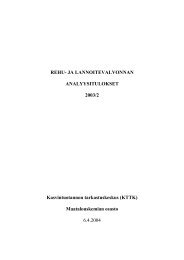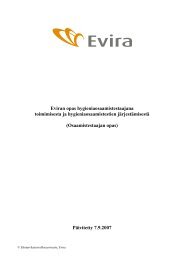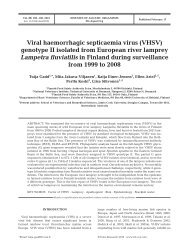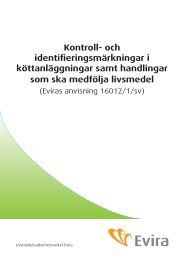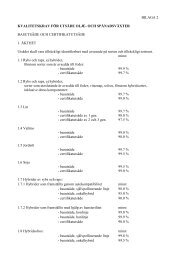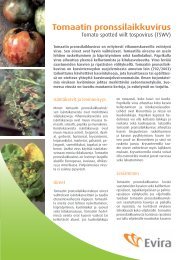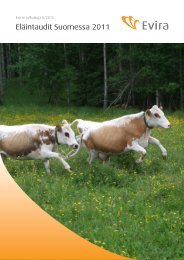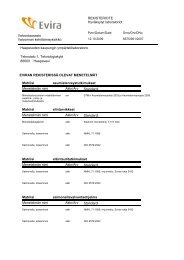Molecular characterization of endemic salmonella infections ... - Evira
Molecular characterization of endemic salmonella infections ... - Evira
Molecular characterization of endemic salmonella infections ... - Evira
You also want an ePaper? Increase the reach of your titles
YUMPU automatically turns print PDFs into web optimized ePapers that Google loves.
2.5.1.4 Biotyping<br />
In biotyping, the pattern <strong>of</strong> activity for 20 or fewer cellular metabolic enzymes is established. Such<br />
data can be routinely obtained if automated systems for species identification are available in the<br />
laboratory. Variation in gene expression is most commonly the reason for isolates <strong>of</strong> the same<br />
strain to differ in one or more biochemical reactions. However, random mutations may also alter<br />
the result (Maslow et al 1993). Strains <strong>of</strong> the same serovar might show different sugar fermentation<br />
patterns, which are determined by the presence or absence <strong>of</strong> enzymes, and hence genetically<br />
determined. For example, the xylose+ and xylose- character <strong>of</strong> S. Typhi may be <strong>of</strong> epidemiological<br />
interest (Brenner 1984). The utilization <strong>of</strong> d-tartrate in serovar Paratyphi B is used to separate<br />
biotype Java that is associated with diarrhoea, from biotype Paratyphi B that is associated with<br />
paratyphoid. Biotype Java can utilize d-tartrate whereas biotype Paratyphi B cannot (Grimont et al<br />
2000).<br />
In many serovars, a subdivision according to the biochemical character yields only a small number<br />
<strong>of</strong> identifiable biotypes. This is because a significant number <strong>of</strong> strains behave differently in only a<br />
few biochemical tests (Parker 1983). Although biotyping is considered highly reliable, the<br />
discriminatory power <strong>of</strong> biotyping is generally low. If multiple isolates <strong>of</strong> an unusual serovar are<br />
detected an outbreak can be identified effectively, and occasionally epidemic strains manifest<br />
unique biotypes (Maslow et al 1993). In conventional biotyping, the results are expressed after a<br />
definite incubation time. When the rate <strong>of</strong> each reaction is read, and the kinetics <strong>of</strong> each evaluated,<br />
a biochemical fingerprint <strong>of</strong> an isolate is obtained (Möllby et al 1993).<br />
2.5.2 <strong>Molecular</strong> genetic typing methods<br />
2.5.2.1 Plasmid pr<strong>of</strong>ile<br />
The first genotypic method used for strain separation within Enterobacteriaceae was plasmid<br />
pr<strong>of</strong>iling (Riley and Cohen 1982). Bacteria <strong>of</strong> the same clonal line are expected to carry the same<br />
plasmids since copies <strong>of</strong> the resident plasmid are distributed between the two daughter cells when<br />
the bacterium divides (Olsen 2000). For strains that lack plasmids or have only one or two <strong>of</strong> them,<br />
plasmid pr<strong>of</strong>iling has poor discriminatory power. Other potential problems arise from the fact that<br />
plasmids are extra-chromosomal elements. Plasmids carrying resistance determinants may spread<br />
rapidly from one strain to another and persist for prolonged periods (Maslow et al 1993). However,<br />
in strains with plasmids coding for drug resistance, plasmids can be lost if antibiotic selective<br />
pressure is withdrawn. Consequently, interpretation <strong>of</strong> typing results may be difficult (Threlfall et al<br />
1994).<br />
25



